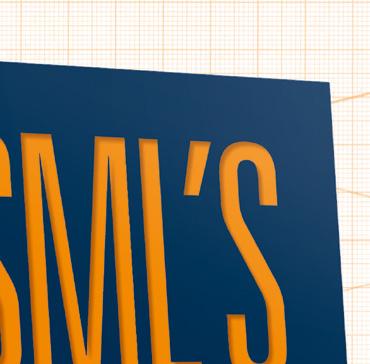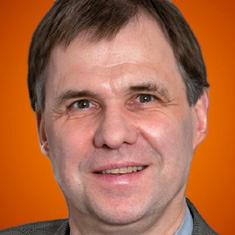
14 minute read
How the conception of ASML took some convincing
Back in the 1980s, Philips wasn’t particularly keen on working with the much smaller company ASM International. Only by cozying up to the Dutch government, ASMI CEO Arthur del Prado managed to nudge Philips into the partnership that we know today as ASML.
Jorijn van Duijn
Advertisement
Around 1980, in the wake of fierce American and Japanese competition, the European Community initiated its first cohesive effort in support of the European microelectronics industry. Within the Netherlands, public awareness about the significance of microelectronics for economic growth in the future rose as well. Yet, it seemed like the Netherlands were missing the boat.
This not only was a source of concern to the Dutch electronics behemoth Philips but also to the much lesser-known semiconductor equipment manufacturer ASM International. Though Philips initially would barely acknowledge the existence of the company from Bilthoven, the firms ended up working together after some shrewd manipulation of Dutch economic policy. The result of that collaboration: ASML.
Sideswiping Philips In an interview published in January 1981, Eduard Pannenborg, director of the prestigious Philips Research Laboratory, complained about the lack of entrepreneurship and initiative with regard to microelectronics in the Netherlands. Philips was alone, according to him.
This caught the eye of ASMI’s founder and chief executive, Arthur Del Prado. So far, the 49-year-old businessman had been trying in vain to get support for his growing company. Neither the Dutch government nor Philips had been willing to take up his overtures. Two weeks after Pannenborg’s interview in the newspaper, Del Prado sent a letter to the Philips executive. The letter clearly stipulated the entrepreneur’s position vis-à-vis the changing economic policies of the Dutch and European authorities:
“I completely agree with many of your comments, in particular your observations concerning the absence of European industrial policy, ... and, finally, with your comments with regard to the Dutch industrial climate in relation to the lack of entrepreneurial spirit in this country.”
Del Prado then continued to applaud Pannenborg’s statements about the Dutch entrepreneurial spirit, even though the businessman politely confronted the Philips executive with the fact that he didn’t practice what he preached. As a national champion in electronics, Philips itself had to lead by example:
“Although we did many proposals for collaboration to Philips, time and again it was the American industry where we did find intensive support for launching almost all of our current and latest products. If you argue that the Dutch young people lack entrepreneurial spirit, I would counter that in my view Philips lacks the pioneering spirit that might co-determine the development of a Dutch ‘Silicon Valley’ in miniature.”
Although the letter was politely acknowledged by Pannenborg’s office, Philips didn’t respond. It seems that big Philips still disregarded the small Dutch company in semiconductor equipment for its size and its impetuous reputation as an equipment supplier. But Del Prado had something up his sleeve, which would turn the tide and put him and his company in the spotlight.
On 19 May 1981, ASM International conducted its initial public offering (IPO) at the United States capital market for technology enterprises, the Nasdaq. A novelty for the Netherlands, ASMI being the first Dutch company to be listed there. This tour de force launched the Bilthoven corporation into the major leagues, a feat that couldn’t be ignored by either Philips or the Dutch authorities.
Enjoying the new attention and admiration, Del Prado seized the opportunity to express his assessment of the Dutch climate for microelectronics publicly. In October 1981, in a page-long article in a leading Dutch national newspaper, NRC Handelsblad, he showed off his achievements and vented his frustrations about the Dutch business environment.
In “Silicon Valley at the Jan Steenlaan”, Del Prado publicly restated the argument of his letter to Pannenborg earlier that year. Deliberately, if not articulated directly, he took a sideswipe at Philips. Also, the Dutch capital market had to catch it. Still, at the end of the article, he emphasized his pride
in being a Dutchman, articulating the hope that the industrial climate in the Netherlands would improve.
Animosity Del Prado’s rising star and his advances toward collaboration didn’t go unnoticed at the Dutch Ministry of Economic Affairs and the Ministry of Education and Sciences. The government officials were interested to learn about his opinion on the matter and included him in some of their deliberations.
In these contacts with the Dutch ministries, Del Prado presented himself as the only legitimate conversation partner on the subject of semiconductor production equipment. By September 1982, he was personally invited as a board member of the Foundation for Centers of Microelectronics (Stichting Centra voor Micro-Electronica, SCME) for a period of three years. The SCME was set up in response to one of the governmental advisory commissions and reports in 1980. Its task was to enlighten the Dutch public about microelectronics beyond the overshadowing predominance of Philips. Through these new interactions with government officials, ASMI became an active player in the transformation of Dutch economic policies.
Del Prado also needed to forge a relationship with Philips. This occurred by fits and starts. After the media attention, the entrepreneur came into contact with several engineers of the Philips Research Laboratory. While this resulted in some visits, real collaboration failed to materialize. Moreover, for the first European Microelectronics Program, Philips and ASMI didn’t cooperate. To the dissatisfaction of Del Prado and the public officials, both companies submitted proposals independently of each other. The ongoing animosity between ASMI and Philips was counterproductive to the interests of both the government and the companies themselves.
Del Prado leveraged his new relationship with the Dutch Ministry of Economic Affairs in his flirtations with the Dutch giant in electronics. Since Philips enjoyed substantial financial support from the Dutch government and the company had argued for more European collaboration, the ministry had the means to urge Philips to hear ASMI out. And Del Prado was persistent, countering every argument of Philips managers against collaboration. It became more and more difficult for Philips to neglect or deny the advances of the small Dutch enterprise.
A new company On 7 October 1982, during a meeting at the Ministry of Economic Affairs in The Hague, Del Prado finally detected an opportunity. In this meeting with the ministry’s interim director-general of industry, Jan Hillige,
Eduard Pannenborg expressing concern about Europe losing ground to the US and Japan in the semiconductor market. Source: De Telegraaf
ORDER NOW





“ASML’s Architects is an impressive book, a curious book and a book for the curious. (…) Clearly a labour of love by Raaijmakers but nonetheless an easy read.” Peter Clarke, eeNews, February 1, 2019







“Rene Raaijmakers’ book on the history of ASML is a monumental work in its depth and breadth from ASML’s beginning through 1996. (…) No tech company’s history has ever been covered to such a degree.” Dan Hutcheson, The Chips Insider, February 1, 2019
and Ab de Boer, the director of the Philips Science and Industry (S&I) department, the intentions of Philips to commercialize an in-house developed lithography stepper machine were discussed. Philips S&I was looking for a resourceful manufacturing partner to introduce the system to the market. Del Prado set himself up as a ministering angel.
After all, lithography was a lucrative market. Yet, a few months earlier, in February 1982, Del Prado observed in a letter to a staff member:

On pre-order now
“As you know, I’m very skeptical to make serious efforts to engage the competitors in lithography, this late, with the big boys in this area (Perkin Elmer, GCA, Hitachi, Canon, etc.). Unless this happens together with one of the big companies like Philips or others, or if we could make a big leap forward in a new direction – x-ray or something else.”
Since Philips seemed to be looking for a partner in lithography, one of Del Prado’s preconditions for engaging the lithography market was fulfilled.
Next to a procurement contract for ASMI’s horizontal furnaces by Philips Elcoma, the wafer stepper constituted the first real opportunity to have Philips and ASMI collaborate. After the meeting, Del Prado wrote a letter to De Boer:
“After ample consultation, I intend to confirm the position of ASM to reassure you that if Philips decides to introduce its wafer stepper into the American and Japanese markets, it could consider ASM as a partner for this project after all. ... Assuming that the wafer stepper is a fairly complete engineered product, ASM will be willing to take up the ‘final assembly’ and marketing of the stepper in America.”
To remove any objections, Del Prado detailed how he envisaged the collaboration, from manufacturing and marketing to development. With regard to the funding of the endeavor, he suggested:
“The eventual need to attract venture capital seems no insurmountable problem for us.
techwatchbooks.nl
Perhaps the Ministry of Economic Affairs might play a role in this regard, in particular if it proves possible to substantiate the spillover effects to the Netherlands.”
Del Prado finished his argument by ensuring that ASMI didn’t engage in speculative projects, which might result in unnecessary risk, but he also pointed to Philips’ responsibilities for the Dutch microelectronics industry:
“Many speak about the leading role of Philips for Dutch microelectronics, and European collaboration is considered of paramount importance by Philips; it would be a pity, then, if an American partner were to be preferred, without giving the opportunity to a young but successful Dutch company with a solid American subsidiary of its own.”
Although it would take another several months to convince Philips, a beginning was made. Del Prado knew which chords he had to play to ensure the attention and backing of the Dutch government. He emphasized that the cultivation of Dutch capabilities and knowledge in microelectronics was of strategic interest and that a collaboration between ASMI and Philips constituted a most promising approach.
The receptivity for his charm offensive was confirmed in a successive letter by Hillige. The public official was content with the intended purchase by Philips Elcoma of ASMI equipment, as well as the considered collaboration in lithography:
“As an attentive observer of the conversation, I cannot evade the impression that an in-depth analysis of the opportunities for collaboration between ASM and S&I might be fruitful ... To conclude, I hope that also through ASM and Philips, the Dutch industry of IC production equipment and materials may capture and retain an international position of strength.”
In his thorough study of the history of ASML, René Raaijmakers has indicated that it would take another six months before Philips would return on Del Prado’s proposal. By September 1983, following a second public offering of ASMI’s stock and Del Prado’s nomination of Dutch Executive of the Year, both parties agreed to create a joint venture in order to market Philips’ wafer stepper technology. The joint venture was named ASM Lithography.
Finally, then, the two Dutch players in the global microelectronics market joined forces in order to propel the Dutch industry forward. The Ministry of Economic Affairs was content. Through Del Prado’s persistence and the ministry’s intermediation, ASMI had managed to convince Philips and create a new Dutch semiconductor equipment company in the prestigious market for optical lithography. In the following years, the Dutch government continued and expanded its support for ASM Lithography. The joint venture proved that collaboration within the Dutch economy could result in promising and highly innovative initiatives.
Jorijn van Duijn has studied the history of ASM International over six years, relying upon interviews and Arthur del Prado’s personal archive. In the capacity of PhD candidate, he’s affiliated with Rijksmuseum Boerhaave and Maastricht University. This article is an excerpt from his PhD dissertation entitled “Fortunes of high-tech: a history of innovation at ASM International, 1958-2008”, which will appear at Techwatch Books late November.
Joachim Burghartz is the director of the
Institut für Mikroelektronik Stuttgart (IMS Chips) and the former director of Dimes at Delft University of Technology.

I dream of electromobility
What do Stuttgart and Delft have in common? Underground train stations, of course, but let’s not talk about these questionable ideas. Let’s talk about the daily traffic jams. The metropolitan area of Stuttgart houses 5.3 million people, many of whom commute over long distances every day between home and work. In Delft – or, even better, the Randstad – this applies to some 8 million people.
Their reasons are diverse. First of all, housing costs are ever-increasing, forcing people to live far outside the city centers where they work. Secondly, public transport has been too unreliable and too expensive to be widely accepted. In the Netherlands, there’s an alternative: a welldeveloped bicycle infrastructure due to the flat landscape. Something we can only dream of in hilly Stuttgart.
But Baden-Württemberg as the first German state governed by a green party has taken on the challenge. The situation in the city of Stuttgart is difficult as the level of pollution is high. The sources of fine dust include exhausts from diesel cars but also from trucks serving the construction sites of the underground train station. The city has taken countermeasures by setting up fences covered with moss and special stationary vacuum cleaners to capture the particles. Their effectiveness is questionable, though.
Better to attack the root cause of pollution. Traffic through the city center has been discouraged and public transport has been made more attractive by reducing the fares. Many employers, including my institute, encourage public transport by financially supporting the so-called job ticket.
Like in many large cities, there’s also a shift to both personal and shared electromobility, including electric cars, e-bikes, motor scooters and e-scooters. The shared vehicles are scattered throughout the city center and even the suburbs. I myself have been driving a BMW I3 for three years. I feel good about that car, since I’m not polluting my city with any exhaust, just with a little brake wear
debris owing to its battery recuperation. I do feel quite bad about still being part of that crazy traffic. Also, the logistics of recharging the car battery happened to be challenging.
This is one of the bottlenecks of electromobility. It should work like those lawnmowers that automatically return to their charging stations. Even better, those autonomous electric vehicles should be able to move to their point of use. Then, shared electromobility would really take off and would work smoothly with public transport, banning more and more cars from the inner city.
A quite interesting side effect of being docked to a charging station is that the resulting network of connected batteries making up for an enormous electric storage infrastructure could seamlessly be used to store energy from photovoltaic generators in urban areas. This will certainly take some time to materialize.
Meanwhile, I’m going to hand in my leased I3. As of 1 November, I’ll be using public transport for my commute to work. And I will switch back to a conventional car or maybe a plugin hybrid, which I will only use infrequently for moving heavy shopping goods and for long-distance travel.
In the long run, I’m counting on new ideas in public transport. In Stuttgart, the train and tram lines are radially pointing to the city center, so you always need to cross that for transfer between suburbs. The city now considers cable cars to better link the outskirts since they can use the existing infrastructure. As a side effect, this should positively add to the image of Stuttgart, which right now is mostly known in the media for its buried train station and high level of pollution.
The ruling green party is working hard to change this image. There are plans to entirely free the university grounds from cars, turning it into a green campus. I’m hoping for electric buses that cross the campus and e-scooters that I could hire through an app to take me from the exit of the train station to my institute. I surely hope for something like this to happen before I retire.










